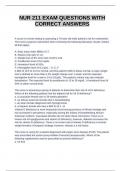Exam (elaborations)
Exam (elaborations) NUR 211 Nursing lifespan Questions with verified solutions
- Course
- Institution
- Book
This post covers NUR 211 final exam questions with the best answers and verified explanations. This questions are useful to the students persuing Nursing .
[Show more]



